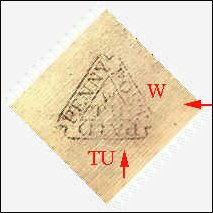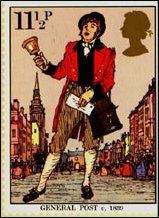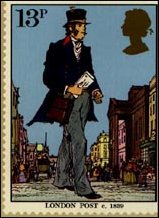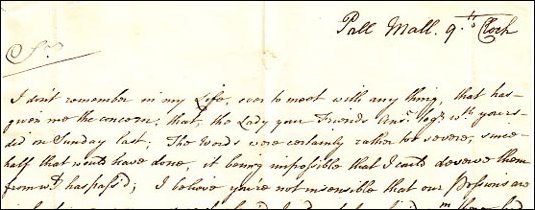These letters graciously have been shared with the Victorian Web by Eunice and Ron Shanahan; they have been taken from their website.

This 200-year-old letter shows that although the language and the postal system has changed, human feelings have not. It was posted in the London Penny Post, and as it is undated, the closest I can come to finding the date is checking on the date stamp. This was applied at the Westminster office, shown by a W in the middle, and it was posted on a Tuesday (TU). This is a type 4b — when the letters in the middle are upright, the word PENNY is on the left. As for the year, it has to be after 1758 when the wording was changed from PENY POST PAYD to PENNY POST PAID, and before 1794 when the London Post was re-organised and a circular date stamp introduced. But I can narrow it down further by the larger size of lettering on this stamp, which came into use from 1784, so this would have been written sometime between 1784 and 1794.
Under the system in operation in the middle of the seventeenth century, there was an 'adequate' service for mail between London and the rest of the country, but if a solicitor in London wished to send a letter to a client in another part of London, he had either to send one of his clerks, or pay for a porter to deliver it for him.
With the growth of trade, and the increase in the population of London — about half a million people — there was an increasing demand for a local London Post. William Dockwra and his partner Robert Murray launched such a service on 27 March 1680, with much publicity, and offered to carry letters, and parcels, within the London area for the sum of one penny.
They started with a Head office in Lime Street, and 7 Sorting Offices. In two years it had grown so much that they required between 400 and 500 Receiving Houses, with messengers who delivered between 5 and 15 times every day. The mail was marked with date and time stamps to show when and where the letter was posted, and that the penny postage had been paid. The earliest known Dockwra postmark is dated 13.12.1680. Most actual Dockwra marks are on letters in archives and only about four are known to be in private hands.
The system which was widely acclaimed and well used, and also profitable, has never been equalled. The Duke of York — the King's brother — complained, claiming it infringed the monopoly of the Post Office, from which he received the profits, which had been granted to him by Parliament in 1663. As a result, Dockwra lost his Penny Post and it was incorporated into the General Post Office, which had thereby gained an efficient organised postal system.
So the new Government Penny Post opened on 11 December 1682. They continued to use the Dockwra system of postmarking the mail with a date stamp. But as the system developed the postmarks changed. In 1685 an abbreviated form of the day was added to the office letters in the centre, e.g. MO for Monday. When the Government took over the organisation, pre-payment was not compulsory. But if the postage was pre-paid, they used a similar postmark. However, unlike the Dockwra postmark, the words on their 'Paid' triangular datestamp read inwards, so the word on the bottom is always upside down.


Left: the bell-man. Right: General post
The Penny Post, from its inception as a government establishment in 1682, and from 1801 as the Twopenny Post, was under the control of the Postmaster General, but was treated as a separate Department. It had its own premises, officers and staff. The Letter Carriers wore a different uniform, so that they could be distinguished from the officers of the General Post. Examples of these different uniforms were shown on a stamp issue from Britain in 1980 for the Rowland Hill Centenary.
The letter is addressed thus: “To Stephen Fuller, Esq. Near North Street Red Lyon Square.” I did an internet search for this, and came across an eighteenth-century description on www.visionofbritain.org
Beginning at Gray's-Inn, and going on to those formerly called Red Lyon Fields, and Lamb's Conduit Fields, we see there a prodigious pile of buildings; it begins at Gray's-Inn Wall towards Red-Lyon Street, from whence, in a strait line, 'tis built quite to Lamb's Conduit Fields, north, including a great range of buildings yet unfinish'd, reaching to Bedford Row and the Cockpit, east, and including Red Lyon Square, Ormond Street, and the great new square at the west end of it, and all the streets between that square and King's Gate in Holbourn, where it goes out; this pile of buildings is very great, the houses so magnificent and large, that abundance of persons of quality, and some of the nobility are found among them, particularly in Ormond Street, is the D — — — of Powis's house, built at the expence of France, on account of the former house being burnt, while the Duke D'Aumont, the French Ambassador Extraordinary lived in it; it is now a very noble structure, tho' not large, built of free-stone, and in the most exact manner, according to the rules of architecture, and is said to be, next the Banquetting House, the most regular building in this part of England.
 The
address is written on an outer wrapper, with a folded letter sheet inside.
It is interesting that had this been dealt with by the General Post, and
not the Penny Post: the cost would have been 'double', as it had an enclosure.
In the enclosed letter which has been torn along the left hand side, the
writing is so close to the edge that it must have been torn off after the
letter was written. There is no address for the sender nor a date it has
only this as a heading: Pall Mall 9 o'Clock.
The
address is written on an outer wrapper, with a folded letter sheet inside.
It is interesting that had this been dealt with by the General Post, and
not the Penny Post: the cost would have been 'double', as it had an enclosure.
In the enclosed letter which has been torn along the left hand side, the
writing is so close to the edge that it must have been torn off after the
letter was written. There is no address for the sender nor a date it has
only this as a heading: Pall Mall 9 o'Clock.
The letter is well written, and has the odd spelling, which is consistent, every time a word ends in 'ed' he has written an apostrophe before the letter d' 'as 'desir'd' 'injur'd' etc. It has lots of capital letters scattered throughout the letter and he has abbreviated many words. Where they are not obvious, I have inserted the word in brackets. He begins with an astonished complaint:
Sir,
I don't remember in my Life, ever to meet with anything that has given me the concern that, the Lady, your Friend ans'd [answered] togr [together] wth yours did on Sunday last; the words were certainly rather too severe, since half that would have done, it being impossible that I could deserve them from wht [what] has passed; I believe you're not insensible that our Passions are involuntary, or you may rest assur'd I wd not have fix'd ym [them] there, had it been in my power to've prevented it, since I'm sensible it was presumption in me to expect success, as I mention'd to her in every Letter, but wd [would] not any man have done wt I did till his letter had been return'd togr with an ansr from her self signifying how far she was offended, I cannot consieve
He then writes what seems to me to be a valid point:
Did not you tell me " if I w'd not come from Paris upon a fortnight's warning for a Lady I would do nothing." — But that is foreign to what I intend by this Letter, I'm far from being displeas'd wth that Lady, for not esteeming me, what I'm uneasy at is, her not letting me know it nine Months ago, & yt [that] she should think me a Villain because I lov'd her.
Then finishes up with his apology:
Oh my God! How severe a thing it is to triumph over those that has it not in their power to make resistance. If that Lady thinks I ever intended or have in the lest [least]sense affronted her I ask her pardon from my Soul, as also yours Sir, if you think I've injur'd you.
I set out for abroad this Eveng & I dare say we never shall see each other more — However it wd give me much more pleasure to be remember'd by you as a friend than an Enemy, since I've from this Hour giv'n up every thought of that affinity yt [that] has occasioned this difference, From your Friend Chas. Handasyde
He must have been an 'honest' man, as he took the trouble to pay the postage on the letter, so that Mr Fuller did not have to pay to receive it, but it sounds as though he is off to join the Foreign Legion to forget this Lady who has spurned him.
15 April 2007